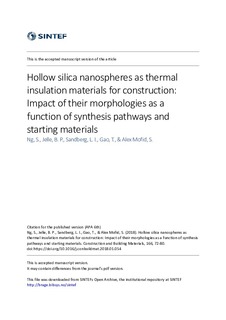| dc.contributor.author | Ng, Serina | |
| dc.contributor.author | Jelle, Bjørn Petter | |
| dc.contributor.author | Sandberg, Linn Ingunn Christie | |
| dc.contributor.author | Gao, Tao | |
| dc.contributor.author | Alex Mofid, Sohrab | |
| dc.date.accessioned | 2018-04-23T11:37:52Z | |
| dc.date.available | 2018-04-23T11:37:52Z | |
| dc.date.created | 2018-01-08T11:09:42Z | |
| dc.date.issued | 2018 | |
| dc.identifier.citation | Construction and Building Materials. 2018, 166 72-80. | nb_NO |
| dc.identifier.issn | 0950-0618 | |
| dc.identifier.uri | http://hdl.handle.net/11250/2495462 | |
| dc.description.abstract | Hollow silica nanospheres (HSNS) show a promising potential to become good thermal insulators with low thermal conductivity values for construction purposes. The thermal conductivity of HSNSs is dependent on their structural features such as sizes (inner diameter and shell thickness) and shell structures (porous or dense), which are affected by the synthetic methods and procedures including reaction medium, polystyrene template, and silica precursor. Formation of thermally insulating HSNS was favoured by alkaline reaction, whereby highly porous silica shells were formed, promoting less silica per volume of material, thus a lower solid state thermal conductivity. The Knudsen effect is in general reducing the gas thermal conductivity including the gas and pore wall interaction for materials with pore diameters in the nanometer range, which is also valid for our HSNS reported here. Further decreasing the pore sizes would invoke a higher impact from the Knudsen effect. The additional insulating effect of the inter-silica voids (median diameter D50 ≈ 15 nm) within the shell coating contributed also to the insulating properties of HSNS. The synthesis route with tetraethyl orthosilicate (TEOS) was more robust and produced more porous silica shells than the one with water glass (Na2SiO3, WG), although the latter might represent a greener synthetic method | nb_NO |
| dc.description.sponsorship | This work has been supported by the Research Council of Norway and several partners through ‘‘The Research Centre on Zero Emission Buildings” (ZEB, project no. 193830) and by the Research Council of Norway through the research project ‘‘High- Performance Nano Insulation Materials” (Hi-Per NIM, project no. 250159) within the Nano2021 program. Furthermore, the Research Council of Norway is acknowledged for the support to the ‘‘Norwegian Micro- and Nano-Fabrication Facility” (NorFab, project no. 245963/F50). | nb_NO |
| dc.language.iso | eng | nb_NO |
| dc.publisher | Elsevier | nb_NO |
| dc.subject | Hollow silica nanosphere; HSNS | nb_NO |
| dc.subject | Thermal conductivity | nb_NO |
| dc.subject | Silica | nb_NO |
| dc.subject | Knudsen effect | nb_NO |
| dc.subject | Insulation materials | nb_NO |
| dc.subject | Nano insulation materials; NIM | nb_NO |
| dc.subject | Insulations | nb_NO |
| dc.title | Hollow Silica Nanospheres as Thermal Insulation Materials for Construction: Impact of their Morphologies as a Function of Synthesis Pathways and Starting Materials | nb_NO |
| dc.type | Journal article | nb_NO |
| dc.type | Peer reviewed | nb_NO |
| dc.description.version | acceptedVersion | nb_NO |
| dc.rights.holder | This is the authors' accepted manuscript to the article. The final publication is available at https://doi.org/10.1016/j.conbuildmat.2018.01.054 | nb_NO |
| dc.subject.nsi | VDP::Teknologi: 500 | nb_NO |
| dc.source.pagenumber | 72-80 | nb_NO |
| dc.source.volume | 166 | nb_NO |
| dc.source.journal | Construction and Building Materials | nb_NO |
| dc.identifier.doi | 10.1016/j.conbuildmat.2018.01.054 | |
| dc.identifier.cristin | 1537492 | |
| dc.relation.project | Norges forskningsråd: 193830 | nb_NO |
| dc.relation.project | Norges forskningsråd: 250159 | nb_NO |
| dc.relation.project | Norges forskningsråd: 245963 | nb_NO |
| cristin.unitcode | 7401,30,40,0 | |
| cristin.unitname | Arkitektur, byggematerialer og konstruksjoner | |
| cristin.ispublished | true | |
| cristin.fulltext | original | |
| cristin.fulltext | postprint | |
| cristin.qualitycode | 2 | |
